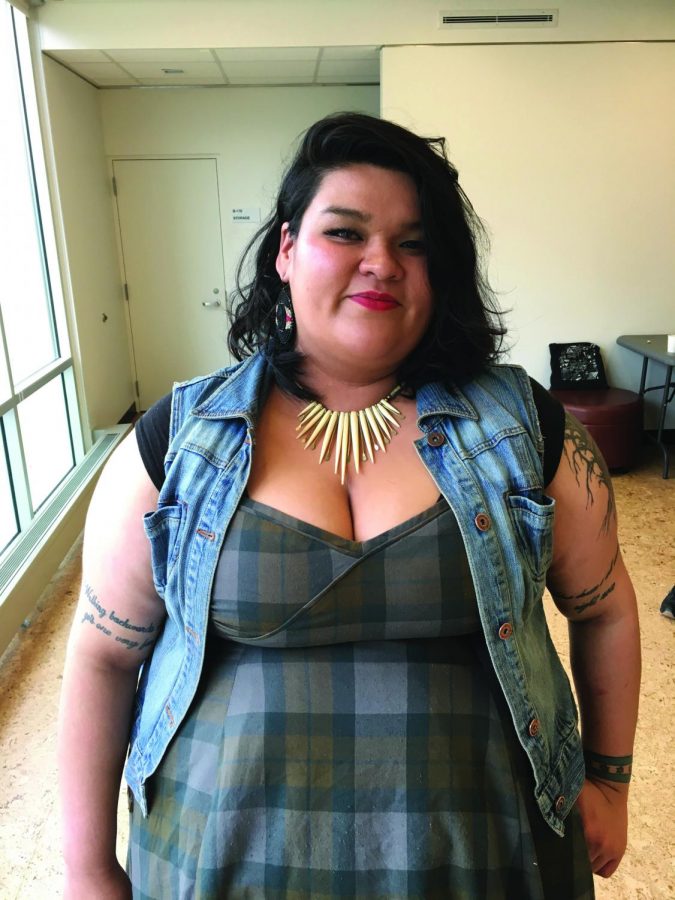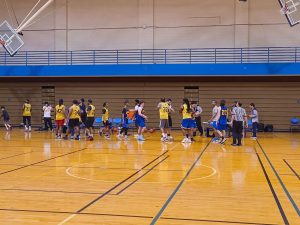Native American and Indigenous Identity in Chicago
Pull quotes from Pochel: “There’s a saying that only natives, horses and dogs are based on a pedigree.” “I have chosen not to be enrolled because I view it as a paper genocide.”
April 10, 2018
American Indian Center of Chicago’s Education Coordinator Fawn E. Pochel spoke to the NEIU community for the Angelina Pedroso Centers “Pandora’s Box” series on March 28.
In 2011 Pochel, her sisters and community of friends began putting together the Chi-Nations Youth Council (CNYC).
CNYC is an inter-tribal organization that builds community, takes action and educates others on environmental issues. CYNC provides a safe space for American Native American and Alaskan Native youth from across the U.S. the opportunity to share their stories to help represent and redefine history.
Pochel became involved with the American Indian Center of Chicago as a research student. She wanted to work with Native and Indigenous youth because she wanted them to have a sanctuary where they can learn, grow and make relationships with other community members.
Pochel began working with Chicago’s Native American community in 2012 on the National Science Foundation research grant project “Living in Relationships.”
Two years later Pochel became a Grow Your Own (GYO) teacher candidate with the Teacher Testimony Project (TTP).
According to GYO’s website, they are “a nonprofit organization that focuses on the recruitment of teachers of color with commitments to their neighborhood school communities.”
During her speech at the Pedroso Center, Pochel explained her mindset as a teacher.“As a pre-service teacher, I think it’s important to realize that education has been a tool in the simulation and genocide of Indigenous populations across the globe. Especially the American Indian education, which started out as boarding schools,” says Pochel, “In our community, we’re at a disadvantage when going into school because of all of the cultural differences but also, we view education as a pathway out of poverty and towards the policy-making table.”
Serving as the education coordinator at the American Indian Center of Chicago, Pochel currently works with the Museum of Natural History on their landscape renovation project. She is collaborating with the museum’s North American section by helping them turn the lawn into prairies with sustainable plants and creating signage for the plants.
Pochel said, “Because we view plants as our relatives, we want to make sure they’re doing it in a culturally salient way, not only for us, for the native people who have always been in Chicago, but for the plant life themselves.”
The American Indian Center, Santiago X, Chicago Public Arts Group and Portage Park Neighborhood Association announced that the Chicago Community Trust awarded the Great Rivers grant to create two sites for the Northwest Portage Museum. The walking museum will feature multiple art installations, gardens, educational material and plant signage. The museum will start at the Chicago River and end at the Des Plaines River, providing the connection on highlighting past and present Native-American history.
“I look at it as my job, as a Native woman, to be the knowledge keeper of these plants and pass this knowledge on,” said Pochel.
The nine-mile-long walking museum is in its first year of development. Two Native American mounds will be constructed by the end of the summer.
At the American Indian Center of Chicago, Pochel and co-workers create and host events for the Native American youth such as Indigenous Science Days, planting medicinal and heritage gardens, powwows and discussions.
Pochel said, “We have a lot of conversations about what it means to be pan-Indian or inter-tribal communities. The term pan-Indian, indigenous people lump together as a monoculture. But, living in Chicago, the American Indian Center currently represents 147 different tribes. We want to continue to represent 147 different tribes and not pan-Indian beliefs that we’re all one people.”
Pochel also talked about the problems many are facing with the blood-quantum classification and federal enrollment as a Native person. She said, “There’s a saying that only natives, horses, and dogs are based on a pedigree. Being native, or claiming the native identity, often falls under-enrollment for American Indian tribes and status for First Nation tribes.”
Blood quantum was a system that U.S. government placed on Native American tribes as a part of the Reorganization Act of 1934. This required Natives to identify to one tribe, even if their ancestry contained more than one. Due to this, many Native Americans had to forfeit their tribal memberships to their other ancestral tribes, which ultimately reduced the numbers of individuals registered for tribes.
The Reorganization Act also determined who was eligible for benefits under treaties.
Many Native American tribes, such as the Navajo Nation, still use blood quantum as a way to determine who becomes a citizen of their tribe.
After proving blood quantum, the individual will receive a “Certified Degree of Indian Blood,” by the U.S. government.
Pochel said, “My father has full-status because he’s a full-blood Native person under Treaty Four in Canada. I myself would only be half-status. I have chosen not to be enrolled because I view it as a paper genocide.”
NEIU student Patricia Leon coordinated the Pandora’s Box event with Pochel. Leon said, “I think these critical conversations are really key and that’s why the Pedroso Center has always sponsored these kinds of events… Reaching out to the American Indian Center was something that I’ve always wanted to do. We sometimes forget that the Native, Indian and Indigenous people are a big part of Chicago.”
Pochel said, “Part of the work I do and part of the work I’ve been doing since I was a teenager, is helping people understand urban Natives’ lived experiences. I often try to create space to share dialogue, it’s why I’m not at a podium with a PowerPoint, because people can’t connect to you as an individual unless they’re hearing your story. I don’t think you can do that through a Powerpoint.”









